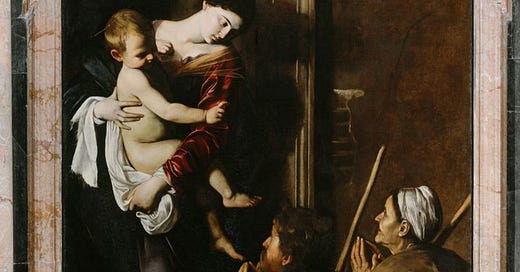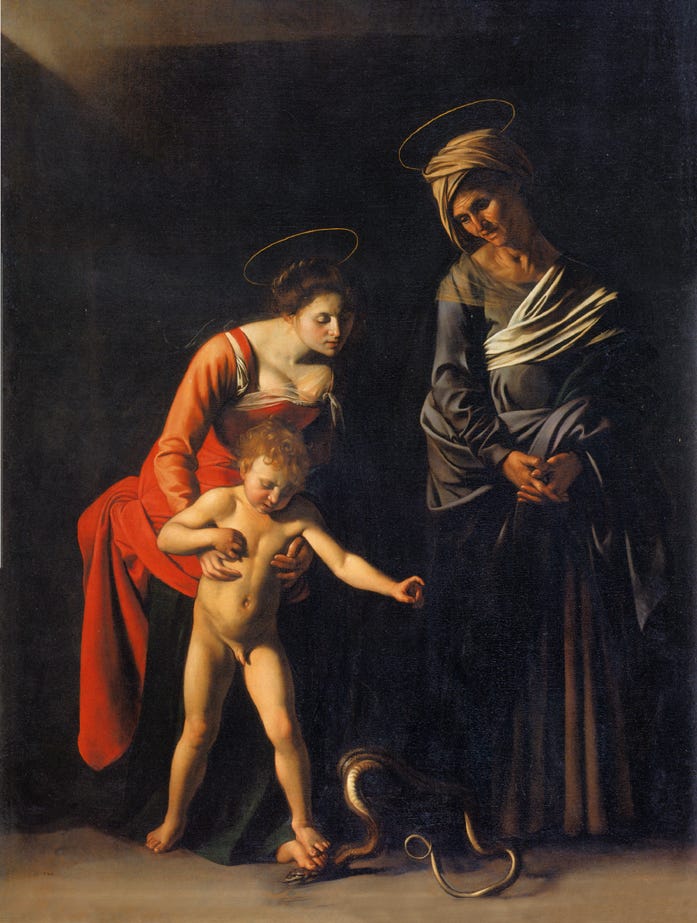Feet. That is what jumps out upon first looking at Caravaggio’s Madonna of Loreto in Rome’s Basilica Sant’Agostino. A triangle at the center of the picture has Mary’s clean, glowing feet on the left and a pilgrim’s dirty, dilapidated on the right, with the baby Jesus’ flopping feet at the top point (three smaller triangles are created by the placement of the feet, albeit with the top of Mary’s obscured). The pilgrim’s feet are the most foregrounded parts of the painting. Two stinking, filthy dogs right there in chapel. The jarring effect of the feet is even more pronounced when seeing the painting in situ, as you look up at the chapel painting from below.
I grew up amongst the large Mormon population of Northern Arizona. It is part of Mormon orthodoxy that Jesus was in the Americas after his resurrection. This opens them up to all sorts of geographical derision. They don’t have a monopoly over wild tales of holy geography, though. As legend has it, the house at the center of the most monumental events in Mary’s life—her birth, the site of the annunciation, and Jesus’ first family home—was transported by angels from Nazareth to Loreto, Italy (with a layover in Croatia; angels need refueling too, apparently). Someone put a cedar statue of the Madonna and Child inside. Constant smoke turned the statue black, giving rise to its famous moniker of the Black Madonna. Loreto has been a major pilgrimage site for ~800 years.
Caravaggio was commissioned to make a picture celebrating the Madonna of Loreto sometime in the early 1600s. It was made as an altarpiece for the side chapel in Sant’Agostino promised in death to marchese Ermete Cavalletti. The subject was demanded by Cavalletti in his will to honor his and his mother’s longstanding devotion to the Madonna of Loreto.
Caravaggio is perhaps most loved for his realism. “It looks like a photograph” is a common refrain. This painting has several levels of such realism. Remember the feet. The pilgrim’s calloused, wrinkled feet are contrasted with Mary’s bright, clean, feminine feet; her right foot arched as if it is waiting for a Christian Louboutin. Then there is Mary’s exquisite shoulder and neckline. Her right shoulder is exposed and her head is titled to accentuate her is long neck leading to her the very particular beauty of her face. Her neck is the center of light in the painting. Pure light shines upon it.
At a social level we find more realism. The third thing I noticed about this painting (after the feet and Mary’s very particular beauty) is the familiarity of her embrace of her baby. He’s gotten a bit too big to be carried around, but someone is at the door and who knows what he’ll get up to on his own. So she bends down with a sigh and schleps him to the door. His left hand finds the comfort of her upper breast bone, while he briefly removes his hand from his grip on her sleeve to make it iconographically clear that he is in fact Christ. Her right hand presses down on his back as her left hand becomes empty of toddler bum while hiking him up. The physical connection that toddler and son share here is something that anyone who has had to physically wrangle a toddler knows all about.
The realism manifested by Caravaggio’s technical genius is of course undeniable, and it is essential to the allure of his pictures. But more interesting, to me, is the deep irrealism that nearly all of them have. The setting of this picture is a kind of stage. She is at the door of her family home in all of its shabbiness. But it seemingly has no interior—it is a black hole. The lighting is artificial. We have that pure light coming from the top left but also a light source on the other side (with a mysterious shadow in the bottom left). The righteous interpretation is that God is spontaneously illuminating Mary in a pure divine light that flows onto the faces of the pilgrims, but I’m tempted to see a whole stage crew off to the left laboring to show Mary at her best.
This is part of Caravaggio’s philosophical inquiry into the limits and purpose of painting. It is a sort of purification of the theatricality of painting. It asks: What is the nature of this thing put onto this canvas? What is your relationship to it as the viewer?
The pointedness of these question is intensified when you consider the theological irrealism. Both Mary and Jesus are very clearly particular humans. Mary is beautiful, but in the wrong way. Jesus is a joyful hellraiser, but in the wrong way.
Mary is portrayed by a real woman—Lena Antognetti—who Carvaggio used in at least one other painting of Mary (Madonna and Child with Saint Anne, Galleria Borghese). Lena was beautiful; she was also Caravaggio’s lover. Suddenly that neck line takes on a new meaning and the light doesn’t look so pure. I can’t find any information about the babe, but he is also very particular. His hair and facial features are ordinary in a theologically extraordinary way.
Most intriguing are the faces. The pilgrims are likely Cavalletti and his mother. The purest devotion would have focused all of our attention on Mary and the child by fully obscuring their faces. But one must get some eternal life by paying for the painting. So we get a bit of his face and much of hers. Caravaggio seems ambivalent at best about these two. Again, his dirty feet are the most salient part of the picture, and her hat is, infamously, torn and dirty. Perhaps we should adopt the righteous interpretation that this is a symbol of their devotion. I think, rather, that it is Caravaggio poking them and their pretensions.
Finally there are the holy faces. Mary’s expression is tantalizingly ambiguous. It is full of beauty and certainly can be read as meeting the orthodoxy. It is calm and is perhaps loving and tender. But there is an edge to it, perhaps the beginnings of annoyance or impatience. Jesus’ face, on the other hand, is full of toddler joy; a full throated expression of glee. Putting them together just reinforces the particular humanity of the moment depicted between mother and child. The message is as the church intended—joyous love—but the messenger is not. And it is all the better for it.






